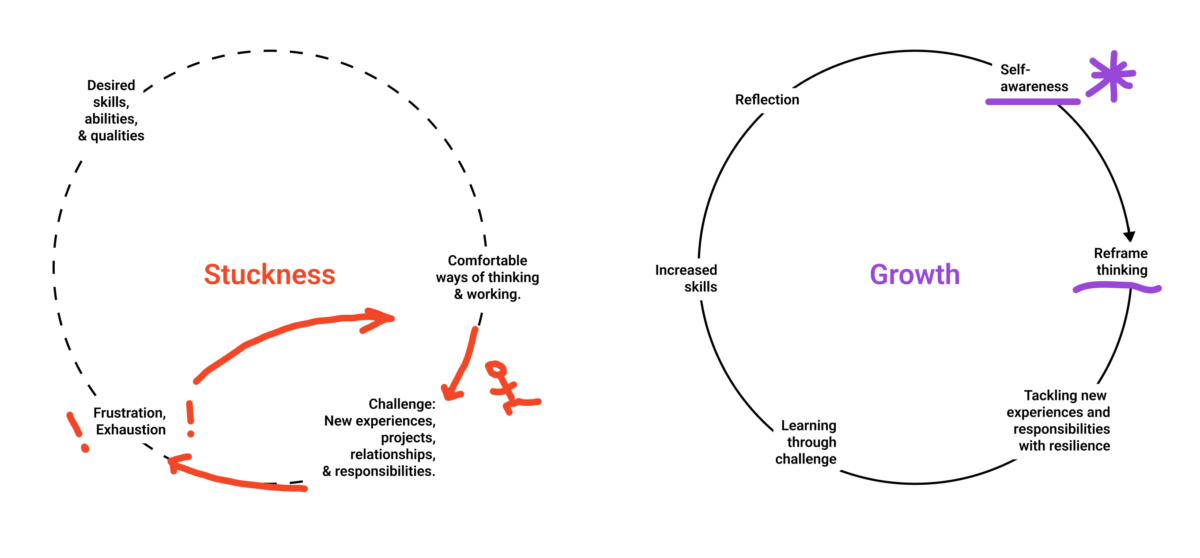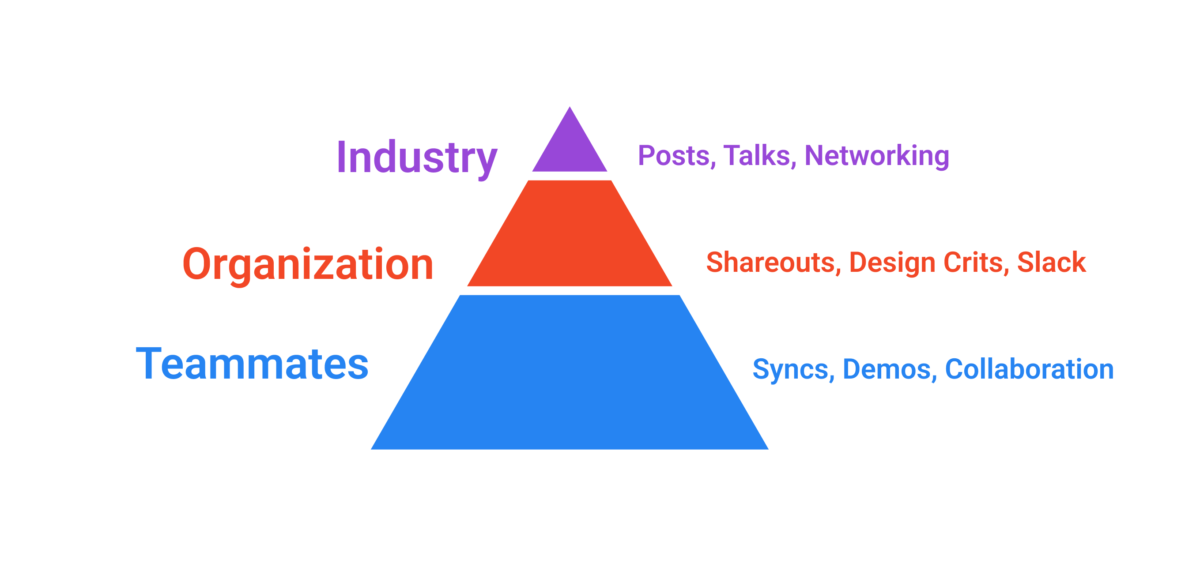This story was originally published on Design at Sprout Social. Our team is planning to share a new post every month, so if you enjoy this one, go check it out!
At the latest Downtown Orlando UX Meetup, we had a discussion based on “A guide to successfully managing up” by Diana Hseigh. While our primary focus at DOUX is user experience, building a strong, collaborative relationship with your boss and leadership team is vital in any field.
As a manager, I want to see the designers on my team succeed, not just with their current projects, but across their entire careers. That’s why I always set aside a 1:1 each month to get outside the day-to-day and chat about personal growth and career goals. Oftentimes, those conversations are about where each individual sees themselves in the future — staying on a craft leadership path or trying out people management, growing as a generalist or leaning into a specific strength, the aspects of their current role that they’re comfortable with, and what challenges them. Knowing what my team members want to achieve is an example of vulnerable visibility on their part, which helps me be a better advocate for their growth.
Performance is a Given
We’re fortunate at Sprout Social to have clearly defined standards and expectations for each role. For product design specifically, each band level has a purpose, a theme, and a scope that act as a lens for interpreting a common set of performance categories across roles. Progressing from Senior Product Designer to Staff Product Designer, for instance, is about demonstrating growth over time across our 8 performance categories while expanding the scope at which your practice your craft:

Craft, Structure, Business, Community, User Knowledge, Domain Knowledge, Reach, and Impact
Annual evaluations and midyear check-in feedback are rarely a surprise because of those regular goal 1:1s, but they are great milestones for reflection. Each 6-month checkpoint is an opportunity for increased self-awareness and, as Boo Fagan illustrated during our last annual review cycle, getting unstuck:

vs a growth cycle fueled by learning through challenges.
Just One Slice of the PIE
Even if you’re consistently zipping around that growth cycle, it doesn’t guarantee that you’re progressing toward that next step on the career ladder. That’s because performance alone only accounts for 10% of professional success, according to Harvey J. Coleman in “Empowering Yourself: The Organizational Game Revealed”. In his book, Harvey explains the PIE formula for success. He asserts that your image or personal brand makes up an additional 30% of your odds and that the remaining 60% of your career success relies on exposure.

How does that concept play out at Sprout? An important part of our process for performance evaluations is calibration. To ensure equity and mitigate subjectivity in our overall ratings, people managers for every discipline get together each review cycle to discuss and align on the feedback they’re planning to deliver.
If I believe someone on my team is killin’ it, but none of my other peer managers ever see that person present in design jams, collaborate with designers in other product zones, or speak up in Slack about things they’re working on, it makes it hard for me to justify an exceptional rating or that they’re ready for a promotion.
Visibility is Vital
In my experience working in tech, a majority of designers, devs, and product folks are quiet introverts who would rather fly under the radar than seek out exposure. Much of the work we do is behind the scenes, and in a remote world, is even more likely to go unnoticed outside the small group of people we work most closely with.
My design team at Sprout is very familiar with the work happening across our zone. We talk candidly about each project we’re working on with our product management partners every Monday morning and have a team check-in each Thursday to discuss the design and research details of everything in progress. Visibility within our team, and among our product partners, is crystal clear. Each designer also attends most of the engineering standups and squad ceremonies for the projects they’re working on, which helps to keep the lines of communication open and ideas flowing through our cross-discipline product zone.
That’s all great for our product zone team culture, but if we’re not sharing the problems we’re working on and the things we’re accomplishing with others across our organization, we do little to build our exposure and image. Even worse, if our colleagues in other zones did the same, we would quickly devolve into isolated silos.
Sharing Really is Caring
Many designers shudder at the thought of selling their ideas, or *gasp* making a name for themselves. Growing your exposure and image doesn’t mean you need to shadow your org’s sales team or become a career politician though. You simply have to care enough about what you’re doing to help others care about it too.
It’s vulnerable to share your work, talk about what you’re learning, and open yourself up to feedback, but the resulting visibility those opportunities create is crucial to your success. Also, when you share your approach to a problem with designers outside your team, they may get inspired or tell you about a similar problem they worked on recently.
With that in mind, I’d like to propose a different 60–30–10 rule. I challenge you to lift up from the focus work you’re doing to share more often. You should spend 60% of that time sharing with your team or cross-discipline zone. While those are the people that likely already know your work the best, it’s most important to stay visible and trusted as a partner to that group. For that audience, the context of how you stay visible is up to how you work with them already. This might look like sharing more research highlights, additional project documentation, demoing prototype updates, or even setting up regular sync meetings with key partners.

Dedicate 30% of your visibility focus to colleagues outside of your direct team. You know your own work better than anyone else, so it’s up to you to make sure that other teams are aware of it. That might mean opening your work up to more design critique, sharing out summaries before a release, or being a more proactive representative of your zone’s work in Slack or Teams channels. Those lines of communication go both ways. You should also be actively seeking to understand work happening on other teams that may intersect with your own.
Finally, allocate 10% of your efforts to sharing with industry peers outside your organization. Writing publicly about your learnings or speaking at conferences and meetups is a great way to practice being vulnerably visible. It’s a common trap to believe that you don’t have anything unique to say or that you aren’t doing anything worth writing about. Here’s the thing—we’re all working in very similar ways, trying to solve very similar problems, so sharing your experience, even if you’re talking about things you tried that didn’t work, helps us all get better. I can tell you from experience that meetup organizers are always looking for potential speakers. 😉 Putting yourself out there will result in connections, and connecting with others in your field also contributes to your overall career visibility.
So, what are you waiting for? Start looking for ways to put yourself out there more this week and see how embracing vulnerable visibility impacts your professional growth. 🌱

[…] Vulnerable Visibility (Jason Beaird) – An interesting idea on increasing the visibility of your work. […]